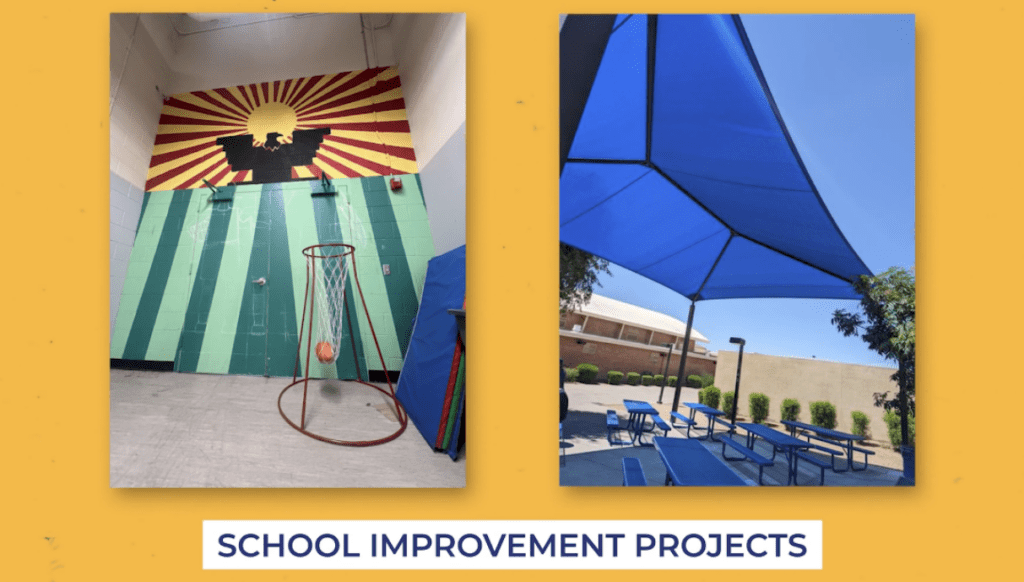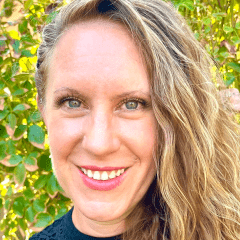Check out this short video from the Center for the Future of Arizona and Arizona State University Participatory Governance Initiative to see School PB in action and hear directly from the students, teachers, and volunteers who come together to make it a reality.
School Participatory Budgeting (School PB) is an innovative and highly malleable civic learning process designed to build student agency, collaboration, and critical thinking skills while creating equitable opportunities for students to participate in authentic, impactful decision-making opportunities within their school communities and prepare for civic life. School PB derives from the municipal Participatory Budgeting (PB) model, which started in Porto Alegre, Brazil, in 1989 and is now implemented in various levels of government, nonprofits, and community organizations worldwide (1). The School PB process is typically organized in five steps and focuses on creating a space for students to advocate for a school community project through collective voice while increasing civic and leadership skills and building relationships:
- Students propose ideas to improve the school community.
- Students transform these ideas into viable proposals by conducting research and considering impacts, costs, feasibility, and sustainability.
- Students campaign for and deliberate on viable proposals by discussing the pros and cons of each.
- The full student body votes on the proposals to select winning projects.
- The winning projects are funded and implemented, with the cycle repeated the following year.
The first School Participatory Budgeting process in the U.S. was implemented in 2013 in Bioscience High School in the Phoenix Union High School District (PXU), one of the state’s largest and most diverse school districts. The expansion of the School PB process in PXU in 2016 was piloted in partnership with Arizona State University’s Participatory Governance Initiative (ASU PGI), the Center for the Future of Arizona (CFA), and the Participatory Budgeting Project (PBP). This initiative aimed to directly involve student voice and choice in allocating a portion of the school budget.

Since then, School PB has been expanding, and Arizona has been at the forefront of experimentation, innovation, and expansion (2). Now, through long-standing partnerships between members of the project team at ASU PGI, CFA, and Arizona K-12 schools, School PB has been adopted and implemented in over 70 schools statewide during the last ten years. Arizona’s pioneering efforts have also inspired the launch of School PB processes in thousands of schools nationwide and internationally. School PB has been growing in different parts of the world in the last decade, from Argentina, Brazil, and Mexico to the United States to Italy, Portugal, Spain, France, Scotland, Poland, Russia, Slovakia, and Georgia, to Romania, and Zambia and Kenya among others (3).
School PB in Arizona has organically been adopted and expanded, with several unique factors to note. For one, School PB started in schools and has spread to municipalities. In most cases of School PB adoption, the reverse is true (municipal to school diffusement). One example is the Budget de la Gente taking place in Tucson, AZ. The Vice Mayor and their team visited a local high school implementing School PB to learn lessons from the youth to implement PB in Tucson’s Ward 1. The Budget de la Gente is now in its third cycle, with winning projects such as neighborhood beautification projects, community storytelling preservation efforts, shade for bus stops, and bicycle repairs and co-ops.
A second unique factor has been the incremental growth and grassroots approach to adopting and implementing School PB. Many school partners opt to pilot the process initially and, after seeing successes, slowly scale School PB across the district. Neighboring school districts have also noted and followed suit in the piloting and slow growth of School PB. Given the budget allocation and dedication in time and resources, the two factors (incremental growth and grassroots approach) have proven to be a successful recipe for longevity.
Another unique factor is the connection between School PB and various subject areas (e.g. civic education, math, financial literacy, social studies, language arts, etc.). School PB provides an authentic civic education experience and aligns with best practices of K-12 experiential learning. Moreover, School PB can be successfully implemented among all ages. For high school students specifically, School PB contributes to Arizona’s Seal of Civic Literacy and School PB lesson plans directly relate to Arizona Civics Exam questions.

The benefits of School PB are numerous. Several studies have shown School PB to empower students to lead as community problem-solvers and acquire skills and attitudes needed for lifelong active civic engagement. Research on civic learning outcomes found students to have increased knowledge of the history and tenets of democracy and public budgets; heightened skills in project management, research, and leadership; improved deliberative and decision-making competencies; and strengthened political efficacy (4). The effects on school climate have been observed in increased levels of trust, peaceful resolution of conflicts, demonstrations of empathy and a common good mindset, and stronger relationships between members of the school community (5). School improvements stemming from a School PB process include changes in educators’ perceptions of young people, heightened leadership competencies among teachers, and tangible improvements to a school’s campus (6).
Additionally, during Vote Days in high schools, after students cast their School PB ballot, some schools partner with community organizations or county recorder offices to conduct voter registration for eligible and interested high school students to be prepared to participate in their upcoming local, state, and federal elections. Since 2016, over 7,000 students have been registered to vote during School PB vote days. In these and many other ways, School PB is an important onramp for students to civic education and robust participation in their communities.
This post is part of our ongoing series, “15 Years: Where We’ve Been & Where We’re Going.” If you enjoyed this, check out our series introduction post as well.
Citations
(1) Dias, N. (2018). Hope for Democracy: 30 Years of Participatory Budgeting Worldwide. Epopeia Records.
(2) Bartlett, T., & Schugurensky, D. (2021). Reinventing Freire in the 21st century: : Citizenship education, student voice and school participatory budgeting. Current Issues in Comparative Education, 23(2), Article 2. https://doi.org/10.52214/cice.v23i2.8571
Bartlett, T., & Schugurensky, D. (2023). Inclusive civic education and school democracy through participatory budgeting. Education, Citizenship and Social Justice, 17461979231160701. https://doi.org/10.1177/17461979231160701
Bartlett, T., & Schugurensky, D. (2024). School Participatory Budgeting: Action civics for democratic renewal. In D. Schugurensky & T. Bartlett (Eds.), Educating for Democracy: The Case for Participatory Budgeting in Schools (pp. 1–22). Edward Elgar Publishing. https://www.elgaronline.com/edcollbook/book/9781035302178/9781035302178.xml
Brown, A. B. K. (2018). School participatory budgeting and student voice [Doctorate Dissertation, Arizona State University]. https://keep.lib.asu.edu/items/157014
Cohen, M., Schugurensky, D., & Weik, A. (2015). Citizenship Education through Participatory Budgeting: The Case of Bioscience High School in Phoenix, Arizona. Curriculum and Teaching, 30(2), 5–26. https://doi.org/10.7459/ct/30.2.02
Gibbs, N. P., Bartlett, T., & Schugurensky, D. (2021). Does School Participatory Budgeting Increase Students’ Political Efficacy? Bandura’s ‘Sources’, Civic Pedagogy, and Education for Democracy. Curriculum and Teaching, 36(1), 5–27. https://doi.org/10.7459/ct/36.1.02
Johnson, S. A. (2023). Examining School Participatory Budgeting Within a High School Context [Ed.D., Arizona State University]. https://www.proquest.com/docview/2817225982/abstract/A604746D7FA74BE6PQ/1
(3) Schugurensky, D., & Bartlett, T. (Eds.). (2024). Educating for Democracy: The Case for Participatory Budgeting in Schools. Edward Elgar Publishing. https://www.e-elgar.com/shop/usd/educating-for-democracy-9781035302161.html
(4) Abrantes, P., Lopes, A., & Baptista, J. M. (2017). The Schools Participatory Budgeting (SPB) in Portugal. Scaling Up Dynamics. https://www.pbatlas.net/uploads/7/0/6/1/70619115/portugal_2.pdf
Bartlett, T., & Schugurensky, D. (2023). Inclusive civic education and school democracy through participatory budgeting. Education, Citizenship and Social Justice, 17461979231160701. https://doi.org/10.1177/17461979231160701
Crum, T., & Faydash, K. (2018). Youth Citizenship in Action: Evaluation of PB in Schools Pilot. Great Cities Institute and University of Illinois at Chicago. https://greatcities.uic.edu/2018/11/02/youth-citizenship-in-action/
Duncikaite, I. (2019, September 12). Participatory budgeting initiatives lead to greater transparency: Example of two Lithuanian schools. IIEP Unesco – Etico | Platform on Ethics and Corruption in Education. https://etico.iiep.unesco.org/en/participatory-budgeting-initiatives-lead-greater-transparency-example-two-lithuanian-schools
Falck, A., Schugurensky, D., García-Leiva, P., & Kumar, N. (2021). How Participatory Budgeting Can Support Education and Learning. Deliberative Democracy Digest. https://www.publicdeliberation.net/how-participatory-budgeting-can-support-education-and-learning/
Gibbs, N. P., Bartlett, T., & Schugurensky, D. (2021). Does School Participatory Budgeting Increase Students’ Political Efficacy? Bandura’s ‘Sources’, Civic Pedagogy, and Education for Democracy. Curriculum and Teaching, 36(1), 5–27. https://doi.org/10.7459/ct/36.1.02
Goshin, M. E., Евгеньевич, Г. М., Sorokin, P. S., Сергеевич, С. П., Kupriyanov, B. V., & Викторович, К. Б. (2025). Agency Manifestations in Schoolchildren and Their Involvement in Participatory Budgeting. Integration of Education, 29(1), Article 1. https://doi.org/10.15507/1991-9468.029.202501.097-113
Murajovas, S. (2019, May 15). Direct democracy in schools increases transparency. Transparency International. https://www.transparency.lt/en/participatory-budgeting-in-schools/
(5) Albornoz-Manyoma, N. G., García-Leiva, P., & Palacios-Gálvez, M. S. (2020). Participation as a mechanism to favour psychological empowerment and positive interaction: The “Ágora Infantil” participatory democracy programme. Journal of Community Psychology, 48(5), 1347–1364. https://doi.org/10.1002/jcop.22328
Brown, A. B. K. (2018). School participatory budgeting and student voice [Doctorate Dissertation, Arizona State University]. https://keep.lib.asu.edu/items/157014
Gibbs, N. P., Bartlett, T., & Schugurensky, D. (2021). Does School Participatory Budgeting Increase Students’ Political Efficacy? Bandura’s ‘Sources’, Civic Pedagogy, and Education for Democracy. Curriculum and Teaching, 36(1), 5–27. https://doi.org/10.7459/ct/36.1.02
Kupriyanov, B. (2023). Diagnostics of School Involvement of Learners Included in the Practice of Participatory Budgeting. Integration of Education, 27(1), 119–130. https://edumag.mrsu.ru/index.php/en/articles-en/120-23-1/1072-10-15507-1991-9468-110-027-202301-7
(6) Bartlett, T., Rock, M., Schugurensky, D., & Tate, K. (2020). School Participatory Budgeting: A Toolkit for Inclusive Practice. Center for the Future of Arizona, Participatory Governance Initiative at Arizona State University. https://spa.asu.edu/sites/default/files/2022-06/spb_toolkit_2020_11_25.pdf
Bartlett, T., Thrasher, K., Rock, M., Schugurensky, D., & Tate, K. (2023). School Participatory Budgeting in Roosevelt Elementary School District. Participatory Governance Initiative, Center for the Future of Arizona. https://doi.org/10.13140/RG.2.2.18171.49447
Galimberti, S. (2025, February 4). School Participatory Budget: Learning democracy by doing. The Himalayan Times. https://thehimalayantimes.com/opinion/school-participatory-budget-learning-democracy-by-doing
Lieberman, M. (2023, February 6). Giving Students a Say in School Spending? A District Leader’s Bold Idea Pays Off. Education Week. https://www.edweek.org/leaders/2023/giving-students-a-say-in-school-spending-a-district-leaders-bold-idea-pays-off
Parrish, M. (2023, December 17). Arizona students are helping to decide school budgets. In the process, they are learning about democracy. The Arizona Republic. https://www.azcentral.com/story/news/local/arizona-education/2023/12/17/why-some-metro-phoenix-schools-are-giving-students-money-to-spend/71624561007/

Tara Bartlett
Tara Bartlett is a member of the North American PB Research Board. She is a Senior Research Analyst for Arizona State University’s Participatory Governance Initiative. Her research focuses on public policy, civic education, and democratic innovations, particularly among youth and within school communities. Drawing upon frameworks of experiential learning and participatory democracy, she employs methods such as community-based research (CBR) and participatory action research (PAR). Tara’s dedication to these areas stems from her passion for integrating opportunities for youth and families in decision-making processes, policy creation, and community empowerment initiatives. Before her current role, Tara spent 14 years as a middle school educator, significantly contributing to curriculum development and professional development in civics and democracy for K12 educators. She has extensive experience with civic education projects at local, national, and international levels, including roles with the Arizona Civic Coalition and several U.S. State Department initiatives.




